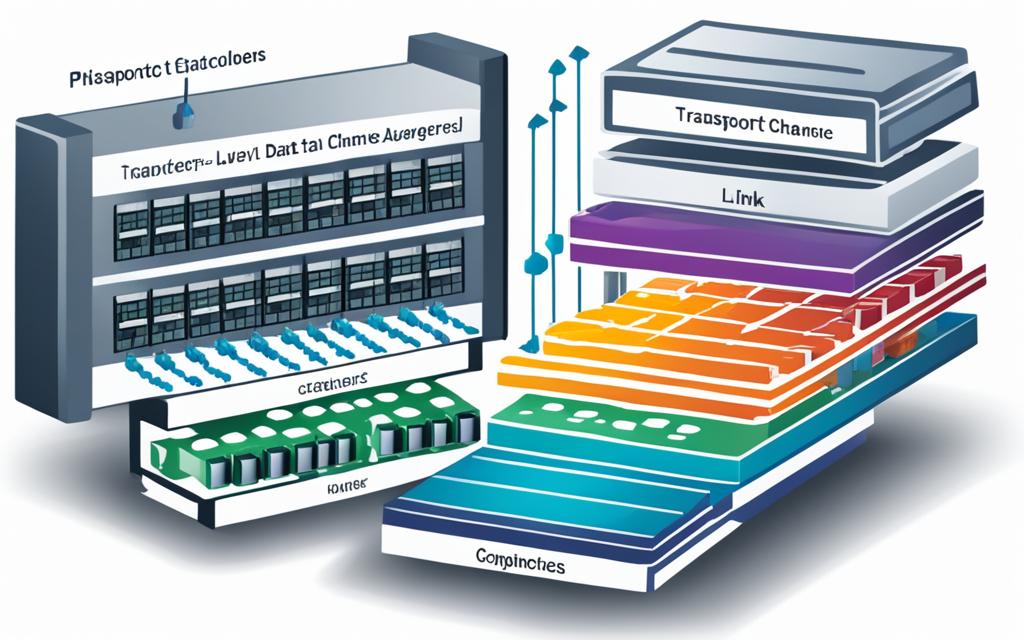Fiber Channel technology is revolutionizing the way data is transmitted in high-speed storage area networks. With data rates of up to 128 Gbps, Fiber Channel provides fast and reliable connectivity between data centers, servers, switches, and storage devices. It offers a scalable solution for high-throughput and low-latency data transfer, making it an ideal choice for organizations with demanding data transfer requirements.
By overcoming the limitations of other protocols and interfaces, Fiber Channel has become the go-to technology for connecting servers to shared storage devices and interconnecting storage controllers and drives. It offers point-to-point, switched, and loop interfaces, catering to various network configurations.
Using the Fiber Channel Protocol (FCP), this technology can transport SCSI commands, ensuring compatibility and interoperability with existing storage infrastructure. This feature allows organizations to leverage their current investments while benefiting from the speed and reliability of Fiber Channel.
What is Fibre Channel?
Fibre Channel is a high-speed networking technology primarily used for transmitting data among data centers, servers, switches, and storage devices. It provides fast, reliable, and scalable connectivity, with data rates up to 128 Gbps. Fibre Channel was developed to overcome the limitations of other protocols and interfaces, such as SCSI and HIPPI, and has become the transmission interface between servers and clustered storage devices. It offers point-to-point, switched, and loop interfaces and can transport SCSI commands using the Fibre Channel Protocol (FCP). Fibre Channel is also compatible with other protocols, such as IP and NVMe-oF, and can be used in high-performance computing environments.
Fibre Channel History and Developments
Fibre Channel, a high-speed serial interface for connecting computers and storage systems, has a rich history and has seen significant developments since its inception in 1988. Initially standardized by the T11 Technical Committee of the International Committee for Information Technology Standards (INCITS) and approved by ANSI in 1994, Fibre Channel has evolved into a versatile and reliable networking technology.
Over the years, Fibre Channel has undergone several speed improvements, enabling faster data rates and enhanced performance. Starting with a data rate of 133 Mbit/s, Fibre Channel has now reached speeds of up to 128 Gbps, allowing for lightning-fast data transfers. These speed advancements have contributed to the growth and acceptance of Fibre Channel across various industries and applications.
One of the key strengths of Fibre Channel is its backward compatibility. Each speed generation of Fibre Channel maintains compatibility with previous generations, enabling seamless upgrades and expansion. This backward compatibility has been instrumental in the widespread adoption of Fibre Channel, as it allows organizations to leverage existing infrastructure while benefiting from the latest technological innovations.
Throughout its history, Fibre Channel has also seen developments in features and functionalities. N_Port ID virtualization, for example, allows multiple virtual servers to share a single Fibre Channel port, streamlining connectivity and increasing efficiency. Another noteworthy development is the improvement in energy efficiency, with Fibre Channel now offering better power management capabilities to reduce energy consumption.
Moreover, forward error correction (FEC) has been introduced to enhance reliability and performance. FEC enables the detection and correction of errors in data transmission, minimizing the impact of noise and ensuring accurate and dependable communication.
To summarize, Fibre Channel has a rich history marked by continual advancements and developments. From its early beginnings as a high-speed serial interface, Fibre Channel has evolved into a mature and versatile networking technology. With its compatibility, speed improvements, and feature enhancements, Fibre Channel continues to be a reliable choice for organizations seeking high-speed, high-performance connectivity for their storage and networking needs.
Fibre Channel Layers and Components
Fibre Channel is a layered technology consisting of five layers of communication. Each layer has specific functions and works together to deliver lossless, in-order, raw block data.
The Fibre Channel layers are:
- Upper Layer Protocol Mapping (FC Layer 4): This layer provides mapping between upper-level protocols, such as SCSI, and the lower Fibre Channel layers. It encapsulates upper-level protocol data into frames for transmission.
- Common Services Layer (FC Layer 3): The Common Services Layer handles services common to all Fibre Channel devices, including flow control, error detection, and recovery.
- Signaling/Framing Layer (FC Layer 2): This layer handles framing, bit encoding, and error detection. It converts frames into a serial bit stream for transmission and vice versa.
- Transmission Layer (FC Layer 1): The Transmission Layer is responsible for encoding and decoding the serial bit stream onto the Fibre Channel medium. It manages and controls the physical transmission of data.
- Physical Layer (FC Layer 0): The Physical Layer defines the electrical, optical, and connector specifications for the Fibre Channel medium. It handles electrical signaling and physical transmission of data.
These layers ensure efficient and reliable data transfer in Fibre Channel networks.
Fibre Channel components play a crucial role in building and maintaining Fibre Channel networks. The main components include:
- Switches: Fibre Channel switches enable high-availability, low-latency, and high-performance data transfer within a Fibre Channel fabric. They provide connectivity and routing capabilities for Fibre Channel devices.
- Host Bus Adapters (HBAs): HBAs connect servers to storage and network devices in a Fibre Channel environment. They handle data communication between the server’s operating system and the Fibre Channel fabric. HBAs offload data storage tasks, improving server performance.
- Ports: Ports establish connections between the Fibre Channel switches and HBAs. They enable the exchange of data between devices within a Fibre Channel fabric.
- Software: Fibre Channel software provides device drivers and control and management functions for Fibre Channel components. It enables configuration, monitoring, and management of Fibre Channel networks.
These components work together to ensure the smooth operation of Fibre Channel networks, facilitating high-speed and reliable data transfer.

Conclusion
Fibre Channel technology serves as the backbone for high-speed storage area networks, providing a reliable and scalable solution for data transmission among data centers, servers, switches, and storage devices. With its fast and secure connectivity, Fibre Channel enables efficient data transfer at speeds of up to 128 Gbps, facilitating seamless communication between interconnected devices.
The layered architecture of Fibre Channel, comprising Upper Layer Protocol Mapping, Common Services Layer, Signaling/Framing Layer, Transmission Layer, and Physical Layer, ensures the delivery of lossless and in-order raw block data, enhancing data integrity and reliability.
Furthermore, Fibre Channel’s compatibility with other protocols, such as SCSI, IP, and NVMe-oF, broadens its application scope, making it a versatile technology suitable for various environments. Whether it is connecting servers to shared storage devices or improving flash storage performance over the network, Fibre Channel consistently meets the evolving demands of modern data solutions.
With continuous advancements and backward compatibility, Fibre Channel remains at the forefront of storage networking, providing organizations with the foundation for high-performance data centers and seamless data flow.
FAQ
What is Fiber Channel?
Fiber Channel is a high-speed networking technology primarily used for transmitting data among data centers, servers, switches, and storage devices. It provides fast, reliable, and scalable connectivity, with data rates up to 128 Gbps.
When was Fibre Channel first developed?
Fibre Channel was first developed in 1988 as a high-speed serial interface for connecting computers and storage systems.
How many layers are there in Fibre Channel?
Fibre Channel is a layered technology that includes five layers of communication: Upper Layer Protocol Mapping (FC Layer 4), Common Services Layer (FC Layer 3), Signaling/Framing Layer (FC Layer 2), Transmission Layer (FC Layer 1), and Physical Layer (FC Layer 0).
What are the components of a Fibre Channel network?
Fibre Channel components include switches, host bus adapters (HBAs), ports, and software.
What is the purpose of Fibre Channel switches?
Fibre Channel switches enable high-availability, low-latency, and high-performance data transfer in a Fibre Channel fabric.
How do host bus adapters (HBAs) benefit Fibre Channel networks?
HBAs connect servers to storage and network devices and offload data storage tasks, improving server performance.
Is Fibre Channel backward compatible?
Yes, each speed generation of Fibre Channel maintains backward compatibility with previous generations, allowing for easy upgrades and expansion.
What is the role of Fibre Channel in storage area networks?
Fibre Channel technology plays a crucial role in enabling high-speed storage area networks by providing fast, reliable, and scalable connectivity for transmitting data among data centers, servers, switches, and storage devices.



















